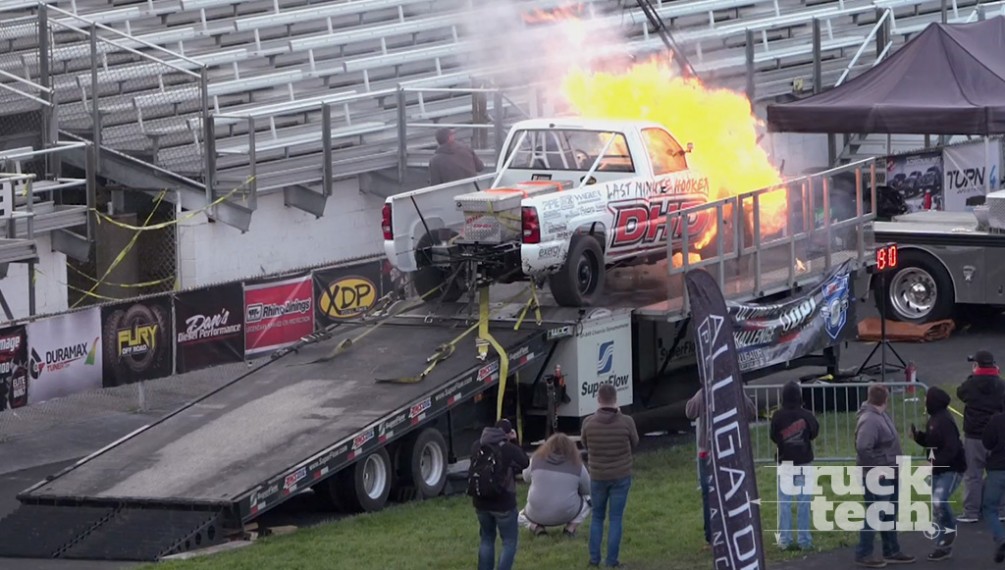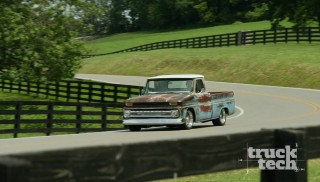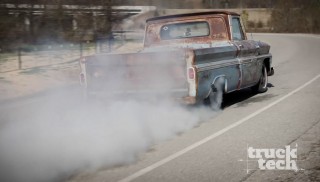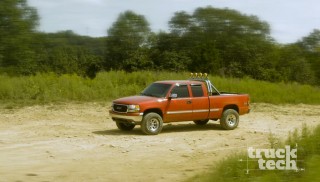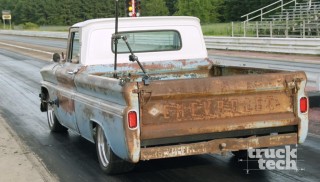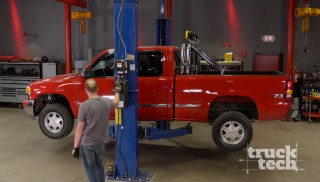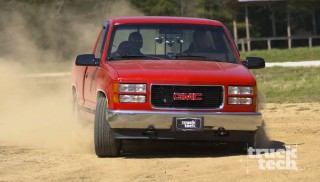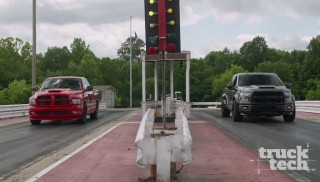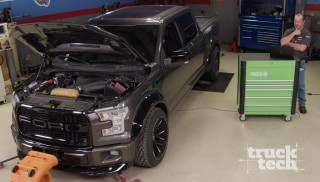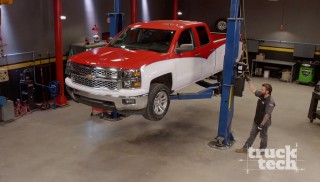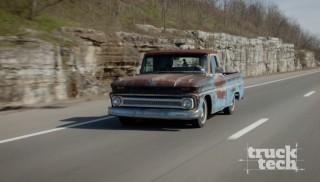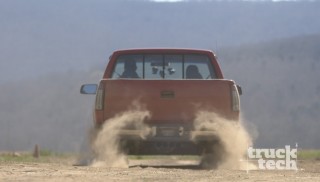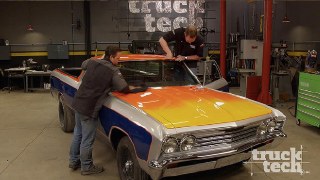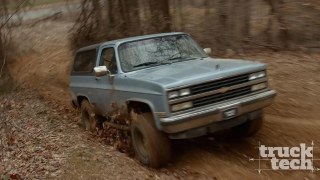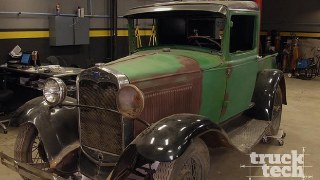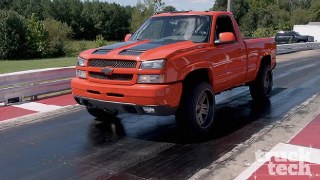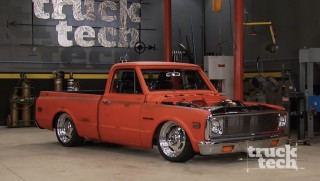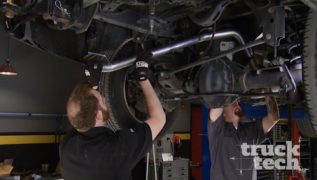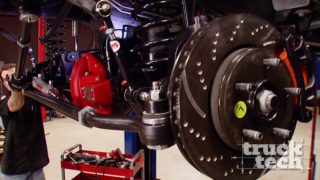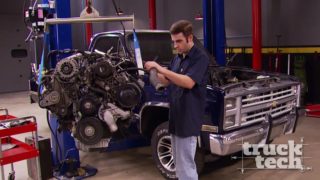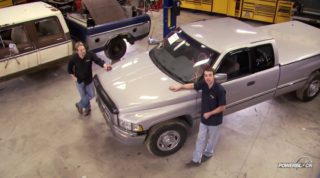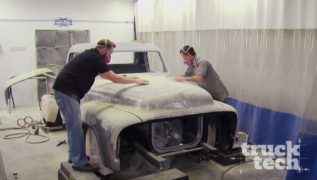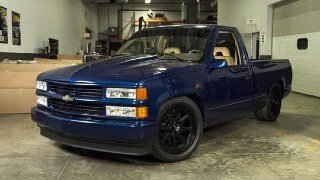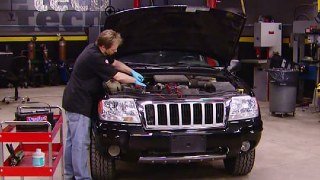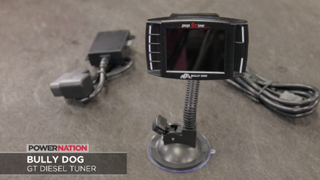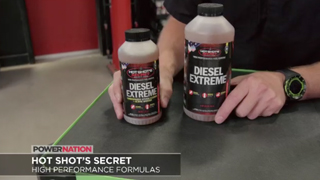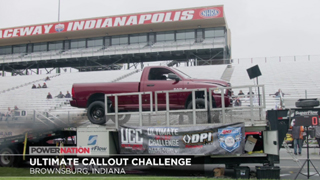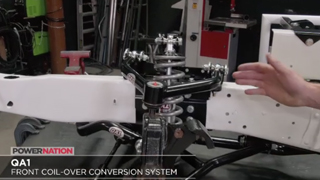Truck Tech Builds
Want more content like this?
Join the PowerNation Email NewsletterParts Used In This Episode
Matco Tools
Matco Tools are the Official Tool Supplier to Truck Tech
The Industrial Depot
Tools, Hardware, and Shop Supplies
Episode Transcript
(Narrator)>> The most extreme diesel competition is in Indy, where these performance addicts risk their rigs in the ultimate call out challenge. Plus our guys go big with their latest, Dragonali. That and more today on Truck Tech.
(LT)>> Three of our very favorite things are high performance engines, racing, and pickup trucks. Now normally it's hard to find all those things at the same place, but not today. We're at the Mecca of high performance diesel, The Ultimate Callout Challenge.
(Austin)>> Hell right here in Brownsburg, Indiana, this event brings together the top 30 diesel competitors in the country, and it's a three stage multi discipline event where they'll compete in drag racing, dyno competition, and sled pulls. These guys have got to adapt their rigs to each one. See who comes out on top.
(LT)>> If there's an insane over the top combination of turbochargers, nitrous oxide, and massive amounts of boost you'll find it right here. Builders prepare all year for this competition but not all the trucks will drive out of the arena under their own power. In its fourth year the Ultimate Callout Challenge has become North America's proving ground for diesel horsepower, and these competitors have thrown out the laws of physics and figured out how to make a heavy weight vehicle go nice and fast.
(James)>> The amount of power these trucks are making is what draws the crowd. Shawn Baca with Industrial Injection, to give you an idea, is making 2,700 horse and almost 3,500 foot pounds of torque or more, which is just insane compared to what some of these other vehicles. You know your stock gas vehicle comes with 300 horse.
(LT)>> One thing that sets this event apart from any other is rules permit major changes to the drivetrain to make the trucks more competitive at each stage. Veteran Shawn Ellerton's team is swapping out gear ratios in advance of the sled pull.
(Shawn)>> Compared to the 2,000 horsepower common rail Cummins that are out here, I mean we're not gonna compete with those guys, but we're here with the other Fords. We're here to compete with ourselves, our personal bests. We've got three different setups, three different events. We bring as much as we can considering we're bringing a six liter Powerstroke to the game.
(Austin)>> Matt Greger and his Pike Feed Sierra is an up and comer getting his feet wet this year competing with the big dogs.
(Matt)>> This is my first time at UCC. I have followed the program for a while now. I think it's super interesting how the truck has to run all three events. It's kinda like a triathlon sort, and I always liked how you have a truck that can do multiple things. We made just under 1,500 horsepower today. Right around where we wanted to be.
(Austin)>> And you can bet next year Matt will be back with a lighter, more powerful truck.
(Matt)>> This is really something you can just drop off at a shop and have them do for you. They'll gladly do it but you're gonna pay for it.
(Chris)>> From the look of the weather it looks like it's supposed to start breaking around three o'clock.
(Austin)>> Rain was prolific the first day and a half, and while head honcho Chris Searle worked out a new schedule with the racers.
(LT)>> We had a chance to check out the DPI Expo.
Over 125 vendors showcased their wares, with diesel high performance in mind for Cummins, Powerstroke, and the Duramax. Hey Mark, how's it going? Good to see you again.
(Mark)>> Yeah absolutely.
(LT)>> A big sponsor this year is AMSOIL and their HD product manager Mark Nyholm knows their lubricants are specifically engineered for what's under the hood of these ultimate race trucks. What special consideration do these guys have to make when choosing and selecting an oil, whether it be for their engine, their drivetrain, differential, or transmission?
(Mark)>> Engines at this power level are pretty unique. Not everybody has one. I mean these guys are running 140 pounds of boost in the combustion chamber. They're running super high temperatures. Like you said, 2,000, 2,500 horsepower. They need the ultimate in lubrication protection to keep their rotating assemblies from coming together. I mean metal on metal is going to end up grenading these things. It lock up bearings, it'll throw rods through the block. So you need great film thickness, great additives to keep that rotating assembly spinning so they can continue making power. I mean abuse on the track trying to do 150 miles an hour is not too much different than the abuse the guys do in pulling 30,000 pounds trying to do 85 miles an hour going down the freeway. I mean they're different horsepower ranges, but the abuse that those engines, transmissions, differentials they see are they're very similar, and you need great lubrication to protect all those components from again. Metal to metal contact, it's bad news.
(Austin)>> One problem diesel owners face is contamination in the fuel. A FASS lift pump cleans the fuel in several ways. It removes water, dirt, and even air, which is why some of today's top competitors have switched over to FASS
(Dorian)>> There's a lot of fuel that we demand on this motor. FASS has a prototype competition 290 pump that we use, and it hasn't failed us.
(LT)>> Diesel Junkie Michael Dalton pilots the FASS Orange Crush for RLC Motorsports.
(Michael)>> When the opportunity presented itself for us to come up we jumped on it because these guys that we're racing with tonight are best guys in this country. What we realized quickly is FASS builds the best fuel pump system on the market. Whether you're driving everyday back and forth to work, towing a horse trailer around the country, or going drag racing.
(Austin)>> Steve Darnell has been running one of the original FASS pumps on D-rod, which is powered by a 12 valve compound turbo Cummins. Today he's upgrading to one of their new titanium signature series lift pumps.
(Josh)>> FASS has been manufacturing lift pumps since 2003 and we've since gone through numerous changes. Now our most recent change is the upgrade to the signature series system. The signature series system incorporates our new, shorter extreme water separator, a particulate filter, electrical connector, and the biggest change is we've added a third bearing, which drastically reduces the sound of the fuel system where you can't even really hear it when the truck's running.
(Steve)>> She runs.
(Narrator)>> Next the competition heats up at UCC.
(Chris)>> Alright, welcome to the UCC. We're drag racing, the rain is gone, and it is beautiful. [ engine revving ]
(Austin)>> This is where the competition gets interesting. These guys are putting out some super high horsepower, some north of 2,000. Trick is do they have the truck set up correct and can they get that to stick to the ground. [ engine revving ]
[ engine revving ]
[ engine revving ]
(LT)>> In a rain soaked first day meant the drag portion of the Ultimate Callout Challenge went well into the evening. The eighth mile run would be the first of three calculations to determine the overall winner. ( )>> How's it feel being in the lead right now?
(Aaron)>> Feels good man. It feels like an unfamiliar place.
(LT)>> At the end it was Aaron Rudolf from Rudy's Performance in the top spot. The dyno portion of the competition is where we find out exactly how much power makes it from the engine down to the rear wheels. Often times it takes a little bit of work to get these trucks spooled up with the turbo, but when they do come alive you better watch out. [ engine revving ]
(LT)>> Austin that thing sounded awesome when it came alive. Those old 12 valves, man they're mean.
(Austin)>> Dude first pull 1,736 horse.
(LT)>> Nothing wrong with that.
(Austin)>> Gettin' it!
(LT)>> Todd Welch from Power Driven Diesel has one of the few mechanical trucks in the field. His turbo Cummins is tuned with springs and screwdrivers, no electronics. He needed a strong finish in the dirt to salvage his weekend.
(Todd)>> If we get it hooked up and going we should pull real far. We've got a lot of traction but I don't know if it's pulling a mud pit. Never done that.
(Austin)>> They're prepping the track for the sled pull. This is one of the more brutal events these rigs are going to encounter all weekend. If something's gonna break it's gonna happen here. This is where you separate the boys from the men. [ engine revving ]
(Austin)>> Todd and his dually hit it hard and won the pulling competition with a distance of just over 326 feet, placing third overall, but it was Tony Burkhardt who became a UCC legend. A nasty explosion charred the Duramax beyond recognition but overnight they rallied the troops with borrowed parts and no sleep. Pulled the sled to a second place come back finish.
(LT)>> Overall champion went to Derek Rose and his 2,500 horsepower DNR Cummins, making him the man to beat for next year's Ultimate Callout Challenge.
(Narrator)>> Next inspired from Indy the boys go shopping.
(LT)>> It was an awesome experience to see some of the action at the UCC, and it really opened our eyes as to how much fun a diesel pickup can be. It was even hard to pick a favorite as the racing, dyno competition, and sled pulling were all a tremendous display of horsepower and torque. In fact we got so inspired we decided to build a truck of our own, and that meant it was time to go shopping.
For our high performance build we were torn between choosing a Cummins based truck or a GM Duramax based truck, and as you can probably guess we chose the Duramax.
(Austin)>> Dude I found it. 2019 LFive-P. This thing is awesome, love it.
(LT)>> Well here's the problem. LFive-P's they make great power but they just barely cracked the codes on the computer and they're able to tune them now, but there aren't a lot of aftermarket high performance parts available just yet. So I don't know, maybe we find a little bit older one? Maybe an LML?
(Austin)>> Man this thing don't even need power. Smells like money in here, it's got a ton of power, we don't even need to do nothing to it.
(LT)>> I know you think that being a Ford guy an all. I'll tell you what. Let's keep looking, you go park this thing.
(Austin)>> Alright.
(LT)>> The next oldest Duramax right behind the LFive-P is the LML. They were made from 2011 to '16 and they put down 397 horsepower and 765 pounds of torque, but my favorite thing about the older LML's is there are plenty of high performance options available. So we can build this truck anywhere from mild, which is Austin's favorite, all the way up to wild, which is where I'm more comfortable.
(Austin)>> Born to be wild dude. This bad boy's wrapped in a 2011 GMC Denali, which is what we wanted for its comfort and features. We already kinda have an idea on what we want to do. Let's just get it back home so we can get started on this build.
(LT)>> Alright, hit the road.
[ engine starting ]
(Austin)>> Burnout.
(LT)>> We have some pretty lofty goals for this truck in terms of a final horsepower figure, but before we get started with a build there's a couple of things that we need. Number one is a sweet pair of acid washed jeans with some embroidery on the back pocket. Really get us in that diesel spirit. And number two is a name. So we've decided to call this Dragonali, and based on that name you can pretty well expect this thing is going to be spending some serious time at the drag strip, but first we're gonna install some basic modification that guys do when they first get their diesel truck, and first on that list is a Bully Dog GT diesel tuner. Now this will get inside the computer and modify parameters for both air flow and fuel. It'll increase power and fuel mileage but it also acts as a gauge display and it will read and clear d-t-c codes. On the towing tune it'll add about 50 horsepower and on the high performance tune 75. Now the other most important modification that I always recommend on a new diesel build are some gauges, and the two most important things to monitor are the pyrometer, which measures exhaust gas temperature, and a boost gauge, which reads engine boost. Now I picked both of these up from Summit Racing as well as the A-pillar pod that they're mounted in. So we'll always be able to tell what the engine's doing at a quick glance, and we'll get started by installing the sensors for these gauges. In order to install the mechanical boost gauge we need to drill and tap into the intake system somewhere between the intercooler and the engine. On an LML there's a short section of the upper intake which can be easily removed from the truck. So there's no chance any shavings will be ingested into the engine. Your vehicle's electrical system is something that's very important to keep in mind when you're working on any engine. Most diesels have an intake air grid heater that's in the upper intake stream. Basically it uses electrical resistance to super heat the incoming air when it's really cold outside. This will air the glow plugs in helping the engine start up when it's cold. Now there's raw current at this part right here and this is a fairly heavy gauge cable, and it's directly connected to the battery. There's no switching in between. So if I were to take my wrench and try to loosen up that nut and I accidentally touched something metal with the other end that's going to cause a direct short to ground, which could cause damage. So an important lesson when working on anything electrical on any vehicle is always start by disconnecting the battery cables, and on a diesel you've got to remember to do both.
With the power feeds safely disconnected the upper intake is removed and we'll drill a pilot hole, followed by a 21/64ths bit. Then the eighth inch n-p-t tap cuts the threads.
Some Teflon tape is applied to create a seal, the fitting is screwed in, and finally we'll blast the intake with air to ensure it's fully clear of any debris. Then it's just a simple matter of re-installing everything back onto the engine in the reverse order of which it was removed. For the most accurate reading the therma-couple, which is the sensor for the pyrometer, needs to be as close to the cylinder head as possible, which means it goes into the exhaust manifold. On a Duramax it's easiest to access the passenger side manifold through the wheel opening, and there's a nice flat spot on the rear of the manifold to tap into. This uses the same eighth inch pipe thread as before. Once the adapter fitting is screwed in the therma-couple slides in about three quarters of the way, and it's secured with the set screw. The wires are run up and across the cowling, through the firewall, and fished up through the fuse panel. The stock A-pillar trim is removed and it gets replaced with a new pod. When wiring gauges, or any 12 volt accessory, it's a good idea to check the service manual to find the best place to tap into power and lighting circuits. The last connection we need to make is installing the boost line to the engine with a nut and feral.
(Narrator)>> Next stay tuned for the tune.
(LT)>> We've got our gauges installed. Everything's wired up, plumbed in, and ready to rock. So now it's time to add some power with our Bully Dog GT diesel tuner. Now I've got it stuck on the window just so you guys can see how easily this thing installs, but after that it's going to live on the windshield, and that means as soon we get this thing in it's time for a test drive.
Anytime you flash a tune you want to make sure that your batteries are fully charged. If for any reason you lose power half way through the e-c-m could become corrupted. Once we've made our selections the updated calibration loads into our LML's computer in about 15 minutes. Alright with the programmer fully installed it's time to fire this thing up and see how those gauges are gonna work. Now normally this'll make about 75 extra horsepower with the Bully Dog, but you guys with the fancy jeans out there, you know that when you drive a diesel wear your good pants there's about another 25 on top of that. Let's check the gauges. [ engine revving ]
(LT)>> Pyro's working, boost it working, we're golden.
Right away the first thing I notice with this GT tuner on here from Bully Dog is the response. I mean I'm not even like trying to go fast. It's just the pedal feel.
(Austin)>> That throttle response is right there.
(LT)>> Exactly, take off from a light. Before it was like there was a big sponge between your foot and the pedal. Now it's just like you put your foot down and you're gone. There's no waiting around.
(Austin)>> It cleans that up for sure.
(LT)>> So 397 horsepower stock. Let's see what a tuned LML will do. Ready? Here we go. Dang. I mean this is 100 percent stock truck, 100 percent emissions intact. It kinda gets it.
(Austin)>> It wakes it up. You can definitely tell a difference from stock you know?
(LT)>> Heck yeah.
(Austin)>> And we're gonna take this truck to the extreme in the coming weeks. We're talking lowered suspension, blacked out exterior, and even compound turbos for the six-six Duramax.
(LT)>> Hot Shot's Secret has a twostep treatment plan that'll create and maintain a healthy fuel system on any diesel truck, and it starts with diesel extreme. Now this will clean out your tank, lines, injectors, and injection pump. Plus it'll give you a seven point bump in cetane, and this stuff is so effective you only have to use it every 6,000 miles. And then on every fill up after that you want to run every day diesel treatment. This will maintain that same seven point bump in cetane. Plus it'll give you a boost in fuel mileage and it'll prevent moisture and corrosion from building up in the first place. To find out more or order yours check out Hot Shot's Secret dot com.
(Austin)>> As you know most old body style Chevy's came from the factory with an automatic transmission. You might find yourself having the desire to swap out that automatic with a manual trans during your build or even daily driver. Well American Powertrain makes that easy for you. With your choice of the five or six speed Tremec they have tailored conversion kits for your '88 to '98 OBS Chevy 1,500 that includes the bell housings, clutch assemblies, fly wheels, and even hydraulic clutch kits. Lastly that revolution shifter mechanism which allows you to run bucket or bench seats. Visit American Powertrain dot com for more.
(LT)>> If you have a '65 to '72 F-100 and you want to bring its handling into the 21st century you need to ditch the twin I-beams and install a QA One coil over conversion system. The double A-arm and rack and pinion design will bring the front down five to seven inches, and the rear will come down four to seven with its torque arm and pan hard bar design. This system is 100 bolt on, which means there is no welding required. To find out more visit QA One dot net, and for more information on any of the parts you've seen on today's show check out Powernation TV dot com.
Show Full Transcript
(LT)>> Three of our very favorite things are high performance engines, racing, and pickup trucks. Now normally it's hard to find all those things at the same place, but not today. We're at the Mecca of high performance diesel, The Ultimate Callout Challenge.
(Austin)>> Hell right here in Brownsburg, Indiana, this event brings together the top 30 diesel competitors in the country, and it's a three stage multi discipline event where they'll compete in drag racing, dyno competition, and sled pulls. These guys have got to adapt their rigs to each one. See who comes out on top.
(LT)>> If there's an insane over the top combination of turbochargers, nitrous oxide, and massive amounts of boost you'll find it right here. Builders prepare all year for this competition but not all the trucks will drive out of the arena under their own power. In its fourth year the Ultimate Callout Challenge has become North America's proving ground for diesel horsepower, and these competitors have thrown out the laws of physics and figured out how to make a heavy weight vehicle go nice and fast.
(James)>> The amount of power these trucks are making is what draws the crowd. Shawn Baca with Industrial Injection, to give you an idea, is making 2,700 horse and almost 3,500 foot pounds of torque or more, which is just insane compared to what some of these other vehicles. You know your stock gas vehicle comes with 300 horse.
(LT)>> One thing that sets this event apart from any other is rules permit major changes to the drivetrain to make the trucks more competitive at each stage. Veteran Shawn Ellerton's team is swapping out gear ratios in advance of the sled pull.
(Shawn)>> Compared to the 2,000 horsepower common rail Cummins that are out here, I mean we're not gonna compete with those guys, but we're here with the other Fords. We're here to compete with ourselves, our personal bests. We've got three different setups, three different events. We bring as much as we can considering we're bringing a six liter Powerstroke to the game.
(Austin)>> Matt Greger and his Pike Feed Sierra is an up and comer getting his feet wet this year competing with the big dogs.
(Matt)>> This is my first time at UCC. I have followed the program for a while now. I think it's super interesting how the truck has to run all three events. It's kinda like a triathlon sort, and I always liked how you have a truck that can do multiple things. We made just under 1,500 horsepower today. Right around where we wanted to be.
(Austin)>> And you can bet next year Matt will be back with a lighter, more powerful truck.
(Matt)>> This is really something you can just drop off at a shop and have them do for you. They'll gladly do it but you're gonna pay for it.
(Chris)>> From the look of the weather it looks like it's supposed to start breaking around three o'clock.
(Austin)>> Rain was prolific the first day and a half, and while head honcho Chris Searle worked out a new schedule with the racers.
(LT)>> We had a chance to check out the DPI Expo.
Over 125 vendors showcased their wares, with diesel high performance in mind for Cummins, Powerstroke, and the Duramax. Hey Mark, how's it going? Good to see you again.
(Mark)>> Yeah absolutely.
(LT)>> A big sponsor this year is AMSOIL and their HD product manager Mark Nyholm knows their lubricants are specifically engineered for what's under the hood of these ultimate race trucks. What special consideration do these guys have to make when choosing and selecting an oil, whether it be for their engine, their drivetrain, differential, or transmission?
(Mark)>> Engines at this power level are pretty unique. Not everybody has one. I mean these guys are running 140 pounds of boost in the combustion chamber. They're running super high temperatures. Like you said, 2,000, 2,500 horsepower. They need the ultimate in lubrication protection to keep their rotating assemblies from coming together. I mean metal on metal is going to end up grenading these things. It lock up bearings, it'll throw rods through the block. So you need great film thickness, great additives to keep that rotating assembly spinning so they can continue making power. I mean abuse on the track trying to do 150 miles an hour is not too much different than the abuse the guys do in pulling 30,000 pounds trying to do 85 miles an hour going down the freeway. I mean they're different horsepower ranges, but the abuse that those engines, transmissions, differentials they see are they're very similar, and you need great lubrication to protect all those components from again. Metal to metal contact, it's bad news.
(Austin)>> One problem diesel owners face is contamination in the fuel. A FASS lift pump cleans the fuel in several ways. It removes water, dirt, and even air, which is why some of today's top competitors have switched over to FASS
(Dorian)>> There's a lot of fuel that we demand on this motor. FASS has a prototype competition 290 pump that we use, and it hasn't failed us.
(LT)>> Diesel Junkie Michael Dalton pilots the FASS Orange Crush for RLC Motorsports.
(Michael)>> When the opportunity presented itself for us to come up we jumped on it because these guys that we're racing with tonight are best guys in this country. What we realized quickly is FASS builds the best fuel pump system on the market. Whether you're driving everyday back and forth to work, towing a horse trailer around the country, or going drag racing.
(Austin)>> Steve Darnell has been running one of the original FASS pumps on D-rod, which is powered by a 12 valve compound turbo Cummins. Today he's upgrading to one of their new titanium signature series lift pumps.
(Josh)>> FASS has been manufacturing lift pumps since 2003 and we've since gone through numerous changes. Now our most recent change is the upgrade to the signature series system. The signature series system incorporates our new, shorter extreme water separator, a particulate filter, electrical connector, and the biggest change is we've added a third bearing, which drastically reduces the sound of the fuel system where you can't even really hear it when the truck's running.
(Steve)>> She runs.
(Narrator)>> Next the competition heats up at UCC.
(Chris)>> Alright, welcome to the UCC. We're drag racing, the rain is gone, and it is beautiful. [ engine revving ]
(Austin)>> This is where the competition gets interesting. These guys are putting out some super high horsepower, some north of 2,000. Trick is do they have the truck set up correct and can they get that to stick to the ground. [ engine revving ]
[ engine revving ]
[ engine revving ]
(LT)>> In a rain soaked first day meant the drag portion of the Ultimate Callout Challenge went well into the evening. The eighth mile run would be the first of three calculations to determine the overall winner. ( )>> How's it feel being in the lead right now?
(Aaron)>> Feels good man. It feels like an unfamiliar place.
(LT)>> At the end it was Aaron Rudolf from Rudy's Performance in the top spot. The dyno portion of the competition is where we find out exactly how much power makes it from the engine down to the rear wheels. Often times it takes a little bit of work to get these trucks spooled up with the turbo, but when they do come alive you better watch out. [ engine revving ]
(LT)>> Austin that thing sounded awesome when it came alive. Those old 12 valves, man they're mean.
(Austin)>> Dude first pull 1,736 horse.
(LT)>> Nothing wrong with that.
(Austin)>> Gettin' it!
(LT)>> Todd Welch from Power Driven Diesel has one of the few mechanical trucks in the field. His turbo Cummins is tuned with springs and screwdrivers, no electronics. He needed a strong finish in the dirt to salvage his weekend.
(Todd)>> If we get it hooked up and going we should pull real far. We've got a lot of traction but I don't know if it's pulling a mud pit. Never done that.
(Austin)>> They're prepping the track for the sled pull. This is one of the more brutal events these rigs are going to encounter all weekend. If something's gonna break it's gonna happen here. This is where you separate the boys from the men. [ engine revving ]
(Austin)>> Todd and his dually hit it hard and won the pulling competition with a distance of just over 326 feet, placing third overall, but it was Tony Burkhardt who became a UCC legend. A nasty explosion charred the Duramax beyond recognition but overnight they rallied the troops with borrowed parts and no sleep. Pulled the sled to a second place come back finish.
(LT)>> Overall champion went to Derek Rose and his 2,500 horsepower DNR Cummins, making him the man to beat for next year's Ultimate Callout Challenge.
(Narrator)>> Next inspired from Indy the boys go shopping.
(LT)>> It was an awesome experience to see some of the action at the UCC, and it really opened our eyes as to how much fun a diesel pickup can be. It was even hard to pick a favorite as the racing, dyno competition, and sled pulling were all a tremendous display of horsepower and torque. In fact we got so inspired we decided to build a truck of our own, and that meant it was time to go shopping.
For our high performance build we were torn between choosing a Cummins based truck or a GM Duramax based truck, and as you can probably guess we chose the Duramax.
(Austin)>> Dude I found it. 2019 LFive-P. This thing is awesome, love it.
(LT)>> Well here's the problem. LFive-P's they make great power but they just barely cracked the codes on the computer and they're able to tune them now, but there aren't a lot of aftermarket high performance parts available just yet. So I don't know, maybe we find a little bit older one? Maybe an LML?
(Austin)>> Man this thing don't even need power. Smells like money in here, it's got a ton of power, we don't even need to do nothing to it.
(LT)>> I know you think that being a Ford guy an all. I'll tell you what. Let's keep looking, you go park this thing.
(Austin)>> Alright.
(LT)>> The next oldest Duramax right behind the LFive-P is the LML. They were made from 2011 to '16 and they put down 397 horsepower and 765 pounds of torque, but my favorite thing about the older LML's is there are plenty of high performance options available. So we can build this truck anywhere from mild, which is Austin's favorite, all the way up to wild, which is where I'm more comfortable.
(Austin)>> Born to be wild dude. This bad boy's wrapped in a 2011 GMC Denali, which is what we wanted for its comfort and features. We already kinda have an idea on what we want to do. Let's just get it back home so we can get started on this build.
(LT)>> Alright, hit the road.
[ engine starting ]
(Austin)>> Burnout.
(LT)>> We have some pretty lofty goals for this truck in terms of a final horsepower figure, but before we get started with a build there's a couple of things that we need. Number one is a sweet pair of acid washed jeans with some embroidery on the back pocket. Really get us in that diesel spirit. And number two is a name. So we've decided to call this Dragonali, and based on that name you can pretty well expect this thing is going to be spending some serious time at the drag strip, but first we're gonna install some basic modification that guys do when they first get their diesel truck, and first on that list is a Bully Dog GT diesel tuner. Now this will get inside the computer and modify parameters for both air flow and fuel. It'll increase power and fuel mileage but it also acts as a gauge display and it will read and clear d-t-c codes. On the towing tune it'll add about 50 horsepower and on the high performance tune 75. Now the other most important modification that I always recommend on a new diesel build are some gauges, and the two most important things to monitor are the pyrometer, which measures exhaust gas temperature, and a boost gauge, which reads engine boost. Now I picked both of these up from Summit Racing as well as the A-pillar pod that they're mounted in. So we'll always be able to tell what the engine's doing at a quick glance, and we'll get started by installing the sensors for these gauges. In order to install the mechanical boost gauge we need to drill and tap into the intake system somewhere between the intercooler and the engine. On an LML there's a short section of the upper intake which can be easily removed from the truck. So there's no chance any shavings will be ingested into the engine. Your vehicle's electrical system is something that's very important to keep in mind when you're working on any engine. Most diesels have an intake air grid heater that's in the upper intake stream. Basically it uses electrical resistance to super heat the incoming air when it's really cold outside. This will air the glow plugs in helping the engine start up when it's cold. Now there's raw current at this part right here and this is a fairly heavy gauge cable, and it's directly connected to the battery. There's no switching in between. So if I were to take my wrench and try to loosen up that nut and I accidentally touched something metal with the other end that's going to cause a direct short to ground, which could cause damage. So an important lesson when working on anything electrical on any vehicle is always start by disconnecting the battery cables, and on a diesel you've got to remember to do both.
With the power feeds safely disconnected the upper intake is removed and we'll drill a pilot hole, followed by a 21/64ths bit. Then the eighth inch n-p-t tap cuts the threads.
Some Teflon tape is applied to create a seal, the fitting is screwed in, and finally we'll blast the intake with air to ensure it's fully clear of any debris. Then it's just a simple matter of re-installing everything back onto the engine in the reverse order of which it was removed. For the most accurate reading the therma-couple, which is the sensor for the pyrometer, needs to be as close to the cylinder head as possible, which means it goes into the exhaust manifold. On a Duramax it's easiest to access the passenger side manifold through the wheel opening, and there's a nice flat spot on the rear of the manifold to tap into. This uses the same eighth inch pipe thread as before. Once the adapter fitting is screwed in the therma-couple slides in about three quarters of the way, and it's secured with the set screw. The wires are run up and across the cowling, through the firewall, and fished up through the fuse panel. The stock A-pillar trim is removed and it gets replaced with a new pod. When wiring gauges, or any 12 volt accessory, it's a good idea to check the service manual to find the best place to tap into power and lighting circuits. The last connection we need to make is installing the boost line to the engine with a nut and feral.
(Narrator)>> Next stay tuned for the tune.
(LT)>> We've got our gauges installed. Everything's wired up, plumbed in, and ready to rock. So now it's time to add some power with our Bully Dog GT diesel tuner. Now I've got it stuck on the window just so you guys can see how easily this thing installs, but after that it's going to live on the windshield, and that means as soon we get this thing in it's time for a test drive.
Anytime you flash a tune you want to make sure that your batteries are fully charged. If for any reason you lose power half way through the e-c-m could become corrupted. Once we've made our selections the updated calibration loads into our LML's computer in about 15 minutes. Alright with the programmer fully installed it's time to fire this thing up and see how those gauges are gonna work. Now normally this'll make about 75 extra horsepower with the Bully Dog, but you guys with the fancy jeans out there, you know that when you drive a diesel wear your good pants there's about another 25 on top of that. Let's check the gauges. [ engine revving ]
(LT)>> Pyro's working, boost it working, we're golden.
Right away the first thing I notice with this GT tuner on here from Bully Dog is the response. I mean I'm not even like trying to go fast. It's just the pedal feel.
(Austin)>> That throttle response is right there.
(LT)>> Exactly, take off from a light. Before it was like there was a big sponge between your foot and the pedal. Now it's just like you put your foot down and you're gone. There's no waiting around.
(Austin)>> It cleans that up for sure.
(LT)>> So 397 horsepower stock. Let's see what a tuned LML will do. Ready? Here we go. Dang. I mean this is 100 percent stock truck, 100 percent emissions intact. It kinda gets it.
(Austin)>> It wakes it up. You can definitely tell a difference from stock you know?
(LT)>> Heck yeah.
(Austin)>> And we're gonna take this truck to the extreme in the coming weeks. We're talking lowered suspension, blacked out exterior, and even compound turbos for the six-six Duramax.
(LT)>> Hot Shot's Secret has a twostep treatment plan that'll create and maintain a healthy fuel system on any diesel truck, and it starts with diesel extreme. Now this will clean out your tank, lines, injectors, and injection pump. Plus it'll give you a seven point bump in cetane, and this stuff is so effective you only have to use it every 6,000 miles. And then on every fill up after that you want to run every day diesel treatment. This will maintain that same seven point bump in cetane. Plus it'll give you a boost in fuel mileage and it'll prevent moisture and corrosion from building up in the first place. To find out more or order yours check out Hot Shot's Secret dot com.
(Austin)>> As you know most old body style Chevy's came from the factory with an automatic transmission. You might find yourself having the desire to swap out that automatic with a manual trans during your build or even daily driver. Well American Powertrain makes that easy for you. With your choice of the five or six speed Tremec they have tailored conversion kits for your '88 to '98 OBS Chevy 1,500 that includes the bell housings, clutch assemblies, fly wheels, and even hydraulic clutch kits. Lastly that revolution shifter mechanism which allows you to run bucket or bench seats. Visit American Powertrain dot com for more.
(LT)>> If you have a '65 to '72 F-100 and you want to bring its handling into the 21st century you need to ditch the twin I-beams and install a QA One coil over conversion system. The double A-arm and rack and pinion design will bring the front down five to seven inches, and the rear will come down four to seven with its torque arm and pan hard bar design. This system is 100 bolt on, which means there is no welding required. To find out more visit QA One dot net, and for more information on any of the parts you've seen on today's show check out Powernation TV dot com.
